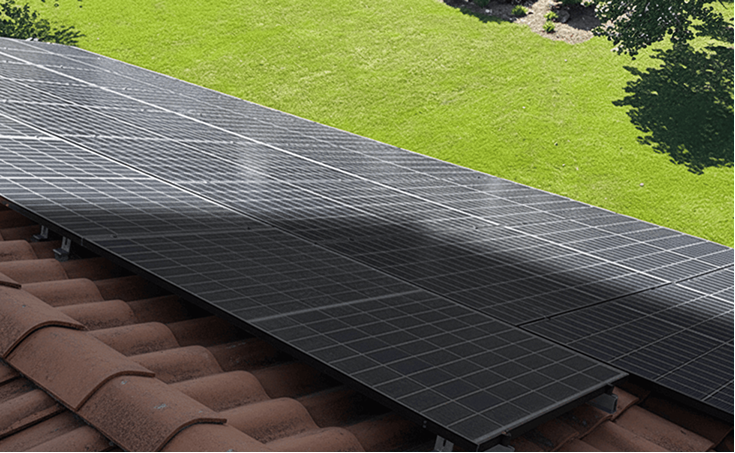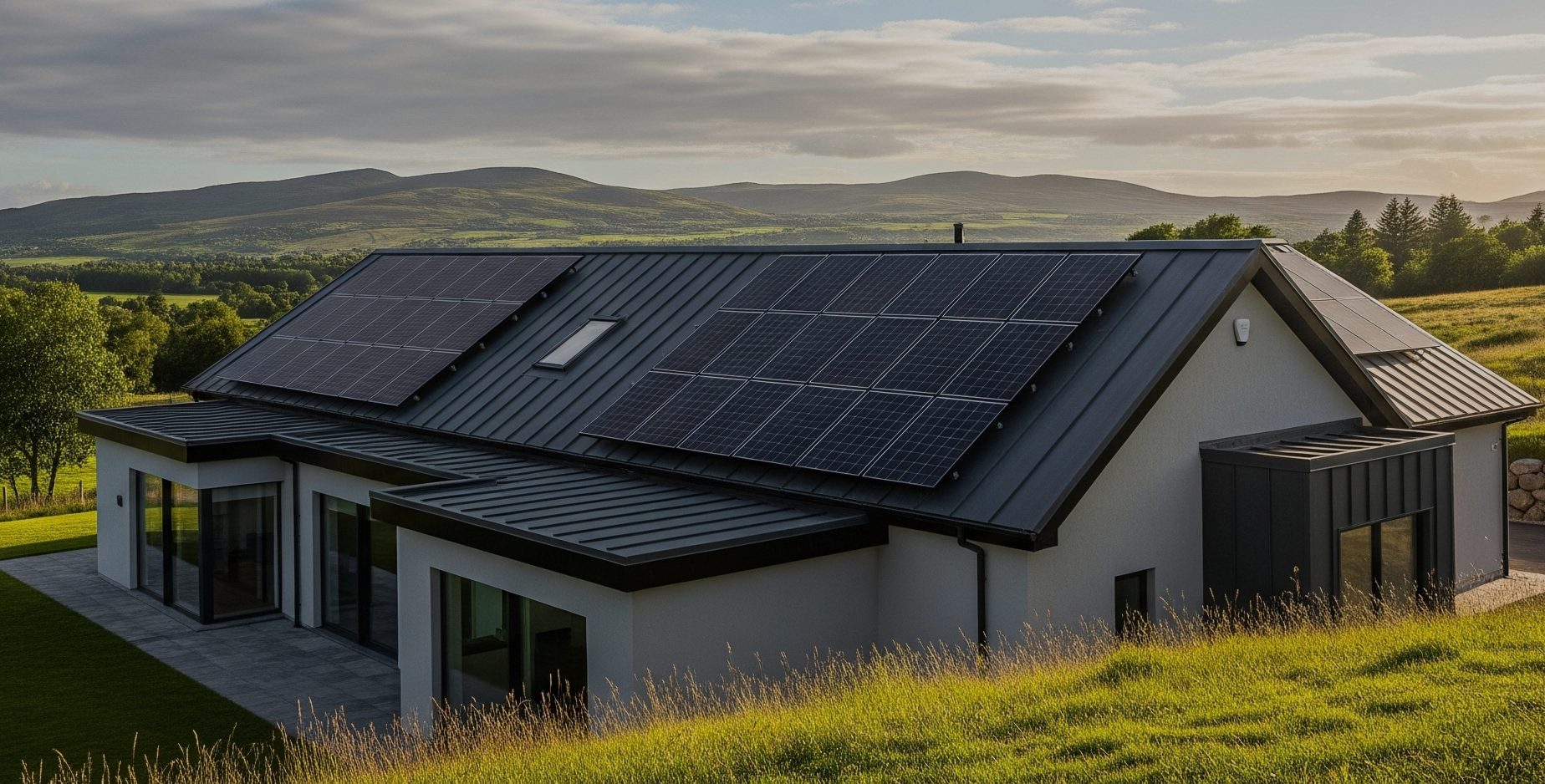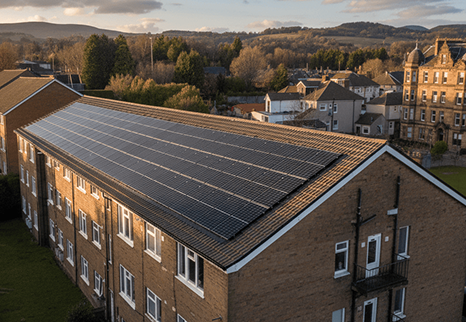Shading on your roof & how it affects your solar panels
Understand how shading affects solar panels in Scotland, from chimneys to trees. Learn about micro-inverters, optimisers, and shade factors to maximize your energy production.

Shading on your roof & how it affects your solar panels
Solar panels are a smart move but there can be some obstacles in the way, like shading, which isn’t uncommon. These obstacles can include things like chimneys, dormer windows, trees, other properties… you get my point. So then you may be thinking, is solar going to work for you?
In Scotland we don’t just have the usual shading problems; we also have a low winter sun, causing more shading than usual. In this article we’ll talk about some of the tech you may have heard about if you’ve ever mentioned shade to an installer. These are micro-inverters and optimisers. We’ll help you figure out if you actually need them or not.
Scottish Roofs & Shading
In Scotland the winter sun is low. Really low compared to our neighbours south of the border. This is a problem when it comes to obstacles in the way (your chimney, neighbour’s roof, satellite dish, trees etc). These all cast long shadows across your panels. This is more of a problem in the winter when we’re already getting fewer daylight hours, and then add extra shade on top…
The summer is generally fine with the sun a lot higher. The worst culprits for shadows are the ones closest to your array. Think chimneys, dormer windows, trees at around 10 metres distance. These tend to create the sharpest, longest shadows and they ruin your energy production if you’re not careful.
Modern panels are better at handling shade than the older ones. Most decent modern panels installed in the UK have half-cut cells and multiple bypass diodes. This basically means if a shadow falls on part of a panel it often only knocks out a sixth or a third of that panel instead of killing the whole thing.
But it is pretty complex. Your panels are connected together in a string (think like Christmas lights); even if only one panel is partially shaded it can drag down the performance of the entire string. Not as bad as it used to be, but still enough to notice on your energy bills. Worst case scenario on a badly designed system, a heavily shaded panel can reduce your whole string’s output by around 50–80% while that shadow is there. To be fair, this is worst case scenario and it’s a lot less common with modern kit and a good design.
What MCS Requires & Why That is Important
MCS Shading Assessment
Mandatory for:
- MCS certified installers in Scotland must do a proper shading assessment.
- The current installation standard (MIS 3002) requires installers to assess shading, document it, and design the system to minimise shade impact where reasonably practical.
Recommended for:
Note: So, if your Shade Factor is 0.9, you are losing about 10% of your potential production to shade over the year. This number then goes on your MCS certificate.
To do so they use a sun path diagram that is split into small coloured segments, and each bit that’s shaded costs you roughly 1% of your annual energy production. Once you add these all up you will get your Shade Factor.
So, if your Shade Factor is 0.9, you are losing about 10% of your potential production to shade over the year. This number then goes on your MCS certificate. It feeds into your official performance estimate. A heavily shaded roof should show a lower predicted output than an unshaded one, which would affect your payback calculations.
The current installation standard (MIS 3002) requires installers to assess shading, document it, and design the system to minimise shade impact where reasonably practical. Which is good and means you should be getting honest numbers as opposed to overinflated promises.
Are Modern Inverters Good Enough?
Modern string inverters have got really good. Brands like Fronius, SMA and Huawei have all developed smart algorithms that can handle partial shading a lot better than older inverters could. They essentially search for the maximum power point instead of getting confused by shadows and settling for less.
A 2024 international study found that in lightly to moderately shaded systems, the difference between DC optimisers and a good string inverter was often under 3% annually. Sometimes the plain string inverter performed better once you accounted for the extra losses in all the additional electronics.
So, if your roof has mild, predictable shading then a well designed string system with decent panels is usually the best value option. However, if your shading is more complex or heavier, or all over the place, this is when these other technologies start to become better options.
A little on the tech..
Micro inverters are small units that get fitted behind each panel or sometimes pairs of panels. They change the direct current into alternating current right there on the roof. The main thing is that each module operates on its own. If one gets shaded the rest keep performing normally. Panels can also be varied in orientations and you don’t need any long high voltage DC cable running through the house, some people do prefer this as they feel it’s safer.
Then you have DC optimisers. These attach behind the individual solar panels too but they communicate with a main inverter. When one panel underperforms the others keep running efficiently because they are running independently.
SolarEdge is a well known brand for optimisers on every panel. Tigo offers selective installation for just the problematic panels. Both fall under the umbrella term Module-Level Power Electronics or MLPE which to be honest just means you've got electronics sitting on every panel.
How much difference do they make?
Tests were done in 2024 and they showed that when comparing optimisers vs string inverters, in terms of modern panels they don’t really give you that extra in day to day performance just for shading. Optimisers aren’t useless though, they just aren’t for everyone. They are best used when you’ve got things like panels that are on the same string but facing different directions, problems with shadows on certain panels, or you want to monitor your panels individually.
They aren’t automatically better though than a good string inverter on a roof with little shade. In fact sometimes they can be slightly worse because of their own conversion losses.
Micro-inverters in complex shade have shown in many studies that you can get an extra 5-25% annual energy output more than a basic string system. You are likely to see more gains with things like when different panels are being shaded at different times of the day, you have got multiple roof faces, the shading pattern moves and changes throughout the day or you just have a complicated roof.
When shading is mild the gain shrinks to just a few percent which might not justify the extra cost. However where shading is heavy or unpredictable then micro-inverters really do well here. They're just more forgiving and less likely to leave you regretting your decisions later.
The Cost
A basic string inverter setup is your cheapest option which is often the best value for unshaded or lightly shaded roofs when considering your average home in Scotland with a 4–6 kWp system.
Typical Costs
Prices are estimates for hardware differences.
A string inverter with selected optimisers on just the panels causing problems costs about £50 to £100 extra per optimised panel in parts.
A full SolarEdge type system (optimisers on all panels plus matching inverter) typically runs £100 to £250 per kWp more than plain string. You do get panel level monitoring and integrated battery options though.
Micro-inverters are the priciest, they’re usually £300 to £600 per kWp more than basic string in hardware. But that's partly offset because you don't need a separate string inverter and you often get longer warranties (20–25 years is common).
The question is though, will the extra energy production pay back that extra cost? For heavily shaded, complex roofs? Often yes. For lightly shaded simple roofs? Probably not.
But are they built to last?
In terms of their environment they differ.
Micros/optimisers are typically mounted on roofs. They are more exposed to the elements – heat, cold and damp. There has been some worry in the industry that roof mounted electronics may fail more often over 20+ years; however, the data is limited. The other issue with roof mounted units is that they require roof access (scaffolding / ladders) which makes them significantly more expensive than swapping out wall mounted units, i.e. string inverters which are more protected and typically mounted indoors or in sheltered areas.
In terms of warranties:
- Micro-inverters: Are around 20–25 years.
- Optimisers: Typically 20–25 years. The central inverter they connect to still has the standard shorter warranty.
- String Inverters: 5–12 years (usually extendable to 15–20 years).
Micro-inverters do not require high voltage DC cables running across the roof as they convert to AC at the panel instead. This can be preferred by people for safety reasons. A bonus for optimiser systems like SolarEdge is that they can mechanically drop voltage to safe levels when the system shuts off.
Both string and module level systems have to meet UK wiring / MCS standards. Both are safe, they just handle voltage differently.
Regarding grid connections
Using micro-inverters or optimisers doesn’t change the required DNO (Distribution Network Operator) paperwork. The grid in Scotland is managed by either SP Energy Networks or SSEN, depending on the location that you are in.
In terms of connection thresholds there are a couple of rules:
- Systems that are less than or equal to 3.68 kW per phase go under the G98 regulations. Here you can install first then notify the DNO later.
- Systems that are > than 3.68 kW per phase fall under the G99 regulations; these must obtain DNO approval before installation.
For compliance all of the equipment, such as string inverters, micro-inverters, and optimisers, has to be type tested for grid connection. The choice of tech is a performance/design choice, not a way to bypass application forms.
Which Option Is Best Suited for You?
Let’s have a look through different scenarios and see which would be best suited to you.
A string inverter would be most suited if….
Your roof is facing roughly south with little shade, or if there is shade preferably it would be early morning or late evening, i.e. missing peak sun hours. You’d have a simple roof layout without major obstructions and you care about getting the best return on your investment. This is probably half the roofs we look at, maybe more. Good panels, a good inverter and a smart string design. Sorted.
A string inverter with some optimisers would be more suited if the following applies:
You have a couple of specific shade issues that you can point to, for example a chimney, a vent. Something that is casting a shadow, for example, over a small part of your array for a few hours each day. Or if you have a bit of your roof that doesn’t get as much sunlight and you want to add it to the same string.
This is more for surgical type fixes rather than full solutions and also if you wanted panel level monitoring without paying for micro-inverters everywhere.
Now a full optimiser system would likely apply if….
The shading on your panels is moderate but constant across multiple panels, for example you may be in a tenement or a townhouse where different panels get different shade even although they are on the same facing roof. Or if you want the integrated DC-coupled battery system and the manufacturer ecosystem is appealing to you. This is pretty popular with SolarEdge in the UK, because it all works together well.
Now for micro-inverters you probably won’t need them if….
You have a complicated roof structure. For example L-shaped, multiple different sections, front and back arrays. Complex architecture can be aesthetically pleasing but a nightmare for solar designs.
Or you may have a lot of shading from moving trees or chimneys that track across the array as the sun moves. Or maybe you’d prefer having no high voltage DC on your roof or would like maximum flexibility for additional panels in the future without worrying about string design.
Essentially this option works when you’re in doubt as it’s the most flexible option. The costs are more upfront but it is also the most forgiving option if the shading is worse than expected or it changes over time.
Here’s What I’d Suggest
Whilst every roof and budget are different and every home / business owner has different priorities. This is what I would suggest:
Get a proper assessment of the shading. Don’t allow for just guesswork or glances at Google Maps. A sun path analysis shows your Shade Factor and where the shadows would fall throughout the year.
Ask for a quote on the following:
- String inverter only.
- String with selective optimiser (if they are relevant).
- Micro-inverters or full optimiser system.
Have a look over the predicted annual output for each of them. Check the upfront cost and the payback period using realistic Scottish electricity prices and export rates.
The difference in annual output can vary e.g. 2–3% or sometimes 15–20%. You want the real numbers for your roof to make a proper decision.
Also, think about how long you are planning to stay in the house. If you are moving, say, in 5 years, then this would be a different calculation than if you intend to stay in your home forever.
A little bit on Installers
Installers that are MCS certified have to do proper shading assessments, this is good. But not all installers are as honest about what the numbers really mean in your system’s performance. A good installer should show you your Shade Factor and explain the meaning of it, and the details like where the shadows fall and when. They should give you realistic options that match your situation and not just try to sell you the most expensive options because the margins for them are better.
If you are being told that every roof needs optimisers or micro-inverters, this is likely overselling. Or if they are saying that shading never matters, then they’re underselling. The truth is usually somewhere in between.
Reach out to us if you want to know what your roof requires.
If you’re anywhere in central Scotland (Stirling, Falkirk, Perth, Dumbartonshire, Glasgow, Clackmannanshire etc.), reach out to us to run a proper shading assessment and show you what your Shade Factor looks like. We’ll give you an honest comparison between different system designs with realistic performance estimates and payback periods.
Get in touch. Let's figure out what actually makes sense for your roof.
Common Questions About Solar Shading
Here are some of the most frequent questions we get from homeowners in Scotland regarding shading and solar panel technology.
Related Articles
Continue reading with these similar topics

The Complete Guide to Home Battery Storage & Funding in Scotland
Unlock energy savings in Scotland! Your guide to home battery storage costs, benefits, ROI, and crucial 2025 funding updates (Home Energy Scotland & ECO4). Cut bills & use more solar.

The Ultimate Guide to Solar Panel Installation in Scotland 2025
Your complete 2025 guide to solar panels in Scotland. Learn about installation costs, grants like Home Energy Scotland, ROI, and the step-by-step process.

What's Possible with Solar Panels for Flats and Tenements in Scotland
Complete guide to installing solar panels on flats and tenements in Scotland. Learn about ownership, consent requirements, SolShare systems, costs, grants, and how to get your neighbours on board.